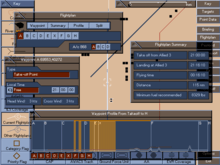Tornado (1993 video game)
| Tornado | |
|---|---|
 | |
| Developer(s) | Digital Integration |
| Publisher(s) | Spectrum Holobyte |
| Platform(s) | Amiga, DOS |
| Release date(s) | 1993 |
| Genre(s) | Combat flight simulator |



Tornado is a combat flight simulator computer game by Digital Integration that models the Panavia Tornado. It was released in 1993 for DOS and Amiga. Tornado is one of the first flight simulations to offer head-to-head online dogfights.
Gameplay
Tornado features high-speed, low-altitude precision bombing runs over a battlefield full of active friendly and enemy air and ground units.It allows the gamer to utilize all complex avionics in both positions of the two-man cockpit. The campaign mode contains a full-featured mission planner. Depending upon rank, the mission planner screen allows the gamer to plot strategies, gather intelligence data, pin-point targets, study mission briefings, draw flight plans (way points and air patrols), verify payloads, and view weather maps. It also provides the gamer with a three-dimensional view of any area of the map. The mission planner contains a dynamic battlefield map, which reflects the results of the player's latest missions. The mission planner allows the gamer to plot and synchronize attacks consisting of multiple flights of Tornados. The game came with a detailed 332 page printed manual, four full-sized color maps and a full-sized, foldable, keyboard reference card.[1][2]
History
Tornado was developed by Digital Integration and released in 1993 for DOS and Amiga. Digital Integration based the Tornado modelling on publications in the public domain, research on open shelves and on the Tornado simulator at RAF Honington. The company consulted the Royal Air Force on various aspects of the game including turn rates, cockpit layout, workings of the weapons systems and wing-sweep mechanics.This authenticity was one of the major selling points of the game.[3]
The Operation Desert Storm add-on was released in 1994. The add-on disk comes with a new desert flying area with 18 new missions, new ground objects for desert scenario, new aircraft and military vehicles, eight new airfields, sixty miles of fortified defences, improved ground force modelling and improved counter air effectiveness. The new warzone also supports campaign play like the original program. The colour schemes of the new aircraft, vehicles, ground objects, and 3D objects are updated for the new desert scenario.
A soundtrack was released along with certain European releases of Tornado CD versions, though the soundtrack never appeared on the US CD version. The music was composed by Dave Punshon and produced by Richard Wells. The tracklist includes "Tornado Theme", "Prepare", "Storm", "Wings", "We Can Fly", "Aftermath", "Freedom", "Triumph March", "We'll be Back", and "Flying High".
In March 2016 in the game community's forum, rumors surfaced that Interplay Entertainment was working on a re-release of the game for digital distribution, based on the original source code.[4]
Reception and reviews
PC Zone's reviewer summarized Tornado with: "The more you play the deeper it gets - eventually you'll need a bathyscaphe. Not for beginners." Of the mission planner, he said: "[it] will impress you so deeply your socks will be blown off. […] it's absolutely incredible." On Tornado's faults, he highlighted the lack of shadow beneath the plane in external view, the use of a single crash sequence regardless of cause of death, the lack of mission replay facility, and the fact that "Digital Integration makes absolutely no concessions to the fact" the gamer had to micromanage both the pilot and navigator roles with their myriad of keystrokes in the heat of the battle. PC Zone gave Tornado a rating of 93%.[1]
PC Review's reviewer described Tornado as "nothing short of comprehensive. […] if you want an accurate portrayal of what it's like to fly a Tornado and the sort of tactics you'll need to stay alive, then this is a superb product." On Tornado's shortcomings, he identified Tornado's weak explosion sounds and suggested that planes should be modeled to "spiral down out of the sky when hit." He also would have preferred to see mission planning involve other aircraft such as "the Apache Gunships and the A-10s." PC Review rated Tornado as 9/10.[2]
Computer Gaming World's reviewer, an F-16 instructor pilot with the Vermont Air National Guard, approved of the accurate flight dynamics but disliked the "oddball" keyboard commands and lack of view modes. He especially criticized the air-to-air combat as "a farce", stating that the limited radar and view modes and poor graphical depictions of enemy aircraft made the game an "arcade reflex shooter"; further, modem play only permitted head-to-head air combat despite the Tornado's strike design.[5]
Together with its Desert Storm expansion, it is considered as one of the all-time classics of flight sims by MiGMan Peter Inglis.[6]
References
- 1 2 MacDonald, Duncan (September 1993). "Review: Tornado". PC Zone. No. 6. pp. 22–26.
- 1 2 Evans, Dean (September 1993). "Tornado". PC Review. pp. 50–53.
- ↑ Stevens, Andrew (September 1994). "An interview With Digital Integration (Part I)". Game Bytes (zipped executable). 13. 22-26. Retrieved 9 July 2016.
- ↑ Tornado source code and Interplay on moodurian.com/tornado by Frankie Kam (March 11, 2016)
- ↑ Fick, Doug (October 1993). "Tornado Kicks Up Some Wind". Computer Gaming World (PDF). 66,68. Retrieved 25 March 2016.
- ↑ Inglis, Peter (2010-11-30). "Tornado". MiGMan's Museum. Retrieved 2016-05-22.
One of the all-time classic flight sims. The training missions covered every aspect of operating the Tornado and you were wise to work your way through them..... this sim gave you more opportunities to 'buy the farm' than most! Player aircraft were Tornado IDS (Interdiction/Strike) and Tornado ADV (Air Defense Variant).
External links
- Tornadoman's Bunker - Official fan site
- Tornado at MobyGames - Game info and stats
- Tornado Forum - Discussion forum